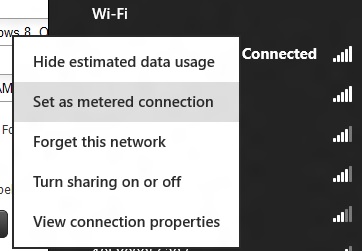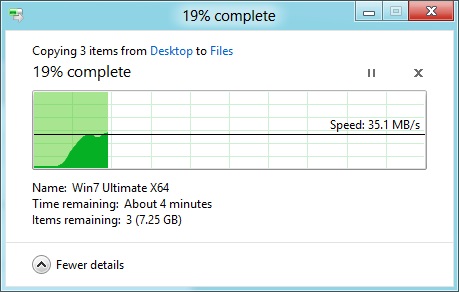In-Depth with the Windows 8 Consumer Preview
by Andrew Cunningham, Ryan Smith, Kristian Vättö & Jarred Walton on March 9, 2012 10:30 AM EST- Posted in
- Microsoft
- Operating Systems
- Windows
- Windows 8
Networking improvements
The widespread adoption of cellular connectivity in an increasing number of laptops and tablets have made our computing devices more mobile than ever before, but it has also given rise to an age of data caps, bandwidth throttling, and exorbitant prices from carriers. In the United States, unlimited data plans are a thing of the past, and as such any operating system worth its salt is going to have to be more careful about what, where, when, and how it sends and receives data.
To that end, Microsoft has instituted several features in Windows 8 that both users and developers can utilize to measure data usage and keep it in check.

Thanks to class drivers (which we'll discuss in just a minute), mobile broadband chips are treated as first-class devices in Windows 8—the same as wi-fi, ethernet, Bluetooth, and USB 3.0, among others—which means that broadband adapters can be turned on and off through the Windows GUI in the same way that wi-fi and Bluetooth now are, and there's also an Airplane Mode can turn all of it off in one swoop, just like on a smartphone (see above). As on phones, Windows will automatically prioritize wi-fi networks when both wi-fi and cellular are available.
This increased integration into Windows has many benefits: if your laptop or tablet has a SIM card installed, Windows can automatically detect which carrier it's associated with and download any available mobile broadband app from the Windows store, and carrier-unlocked laptops and tablets can choose between multiple cellular carriers if the hardware supports it. Windows also offers estimated data usage figures when connected to cellular networks, and when connected to a cellular network the OS will adjust its default behaviors to conserve bandwidth (for example, deferring the automatic downloading and installation of Windows updates until wi-fi is available).

Though it is off by default, these bandwidth conservation features can also be enabled for traditional wired and wireless network connections by right-clicking the name of the network you're connected to. While on a metered network, apps can now use new APIs to force network-aware Metro apps to use less data when possible (another example: using a low-bandwidth movie stream rather than a high bandwidth one). Network-aware Metro apps are required to use these APIs, and users can check how much bandwidth apps are using (both on metered and non-metered networks) in the new Task Manager.
Improvements to networking in Windows also extend to file copying, namely the SMB networked file sharing protocol. In Windows 8, the protocol can now shift dynamically between different network adapters during copy operations so that it always uses the fastest possible connection to transfer files. To demonstrate, I began copying a few gigabytes of data to a fileserver on my home network using a slow wireless G connection:

Then, without pausing the file copy operation or disabling my wireless card, I plugged the laptop into the network with a gigabit ethernet cable:

As you can see, as soon as Windows detected a faster network interface, it without complaint began copying the files using the faster connection. I then unplugged the laptop from the ethernet cable:

Again without issue, it switched back to the slower connection and continued copying the files. While this flexibility is impressive, it should be noted that it can only kick in for file transfers between two Windows 8 (or Windows Server 8) computers.
Drivers
Windows Vista broke a lot of things when it launched, and drivers was a big one—at least part of Vista’s caustic reputation was earned because third-party drivers made the platform so unstable. Since then, Microsoft has been committed to maintaining driver compatibility between Windows versions. During my testing, I found that the vast majority of drivers certified for Windows Vista and Windows 7 worked without issue in Windows 8, lending credence to Microsoft’s assertion that Windows 8 will be able to run on anything that could run Windows 7.
Windows 8’s main innovation is the sheer number of class drivers it introduces. For the un-indoctrinated, class drivers target defined specifications rather than specific hardware. Class drivers are the reason you don’t need to install specific software to run things like mice, keyboards, or USB 2.0 controllers.
Windows 8 adds new class drivers for things like USB 3.0 controllers, printers, motion sensors, mobile broadband cards, and a few others, all of which should be very useful on modern systems running Windows 8 or Windows on ARM. My personal experience extends to the USB 3.0 driver, which worked just fine for the oddball Fresco controller in my Intel desktop board, and the printer drivers, which worked well for a variety of local and networked printers I connected to from my various Windows 8 testbeds.
Microsoft also provides a new basic display driver in Windows 8. While the old generic display driver ran using the Aero Basic theme, the new driver appears to have basic support for Aero effects and transparencies. Among the systems that I tested, only a few had GPU-specific graphics drivers that installed from the DVD. While this may not be true of the RTM version of Windows 8, it looks like Microsoft is scaling back on the number of included graphics drivers to save space—you’d best check Windows Update or your manufacturer’s web site for updated graphics drivers, if they’re not included.










286 Comments
View All Comments
rs2 - Sunday, March 11, 2012 - link
Seriously? I do not want either of those things.Please tell me that these are artifacts of running Windows 8 on a system with an underpowered graphics card, or at least that the rounded corners and "glass" effects simply have not been built in to the preview version.
Andrew.a.cunningham - Sunday, March 11, 2012 - link
Square windows here to stay, not a big deal. Windows borders can get more or less opaque depending on your settings, just like in 7.rs2 - Monday, March 12, 2012 - link
Maybe not a big deal, objectively speaking, but it feels like a step backwards to me. Between that and Metro I'm seriously considering just sticking with Windows 7. It does everything I need in a way that I like, with no trade-offs being made to support touch-based devices (which my desktop isn't).I'm starting to get the feeling that Microsoft could have another "XP vs. Vista" debacle on its hands, no? Back then I switched to Vista but never really felt that it was a significant improvement until Windows 7 came around. I didn't hate Vista or think that it was worse than XP the way a lot of people seemed to, but I wasn't really thrilled with it either. Windows 7 was an unquestionable improvement over both Vista and XP, however.
Perhaps this time I'll stick with "legacy" Windows 7 until Windows 9 comes out.
Andrew.a.cunningham - Monday, March 12, 2012 - link
Totally possible! Especially so in businesses, which move more slowly and are only now rolling 7 out over XP.The rounded vs. square corners thing is a matter of taste, I guess. It does seem to be showing up everywhere - Lion killed rounded buttons in favor of squared ones too. It's not important to me, but I suppose it is a little "old-school." :-)
AnnonymousCoward - Sunday, March 11, 2012 - link
Every new OS simply needs an option to use the old UI. That would take away the fundamental reason why users don't want newer OS's.I refuse to use anything beyond XP. Vista's and 7's Explorer is less functional, and other various UI functionality is different for the worse. Likewise, IE7/8/9 have a topbar that lacks real functionality and can't be customized, unlike IE6.
DanaGoyette - Monday, March 12, 2012 - link
Here are a couple of oddities I've noticed:* Start screen... If you try scrolling horizontally with a touchpad, absolutely nothing happens. In the developer preview, I had to read online to find out why the danged thing wouldn't scroll.
* Split-up search sucks.
Try this in Windows 7: Windows key -> "featu". So long as you don't have, say, "bluetooth feature pack" installed, you can just press enter to get to "Programs and Features".
Try it in Windows 8: Windows key -> Featu. Down, down, enter, enter. 4 key presses required to replace the original 'enter'.
* Start screen, another thing to try: Windows 7: search for something, then press the "context menu" key on the keyboard. You should get the right-click menu of the highlighted item. Windows 8: you get the right-click menu for the textbox you're typing in!
* The boot process seems weird on my Intel 320 SSD. After the initial disk activity, it sits there doing apparently nothing (no disk activity) for over 30 seconds. Effective boot time is around 60 seconds, not including POST. For comparison, resuming from hibernate to the login screen takes only about 4 seconds.
* You ever try it on a pen-only (Wacom) Tablet PC? It's worse than a mouse, because it seems to actively disable the screen corner gestures -- they don't work with the pen OR the touchpad on that system.
Now, for a nifty thing to try: right-click in the lower-left corner of the screen.
mbf - Monday, March 12, 2012 - link
Fixed that error on page 3 for you:"..Microsoft insists that the PC is just another kind of tablet..."
vivekgarg79 - Monday, March 12, 2012 - link
I have x86 (32 bit) m/c. I want to develop metro UI app, using VS2011 for windows 8. Will VS 2011 (x86) work on top of Windows 8 consumer preview (x86)??haplo602 - Monday, March 12, 2012 - link
I read the first 3 pages, then skipped to the conclusion. I realised I don't give a damn about any new Windows/Tiles version. Happy Linux camper since Windows XP.The UI change will be a big jump. It will be interesting to see the outcome.
iwod - Monday, March 12, 2012 - link
I couldn't believe how positive this review was, from a technical user prospective.And it surely prove M$ has little to no understanding of how UI should be designed. There is now Metro, and a half baked Desktop environment. I can see more user jumping on to Mac platform when Windows 8 comes out.
I think the root of all wrong doings; Tablet is just another PC. Which is where it all goes wrong.
P.S - I have been forcing Metro on myself for week now. I can definitely say it "could" be a great Tablet OS. Desktop? I will pass.